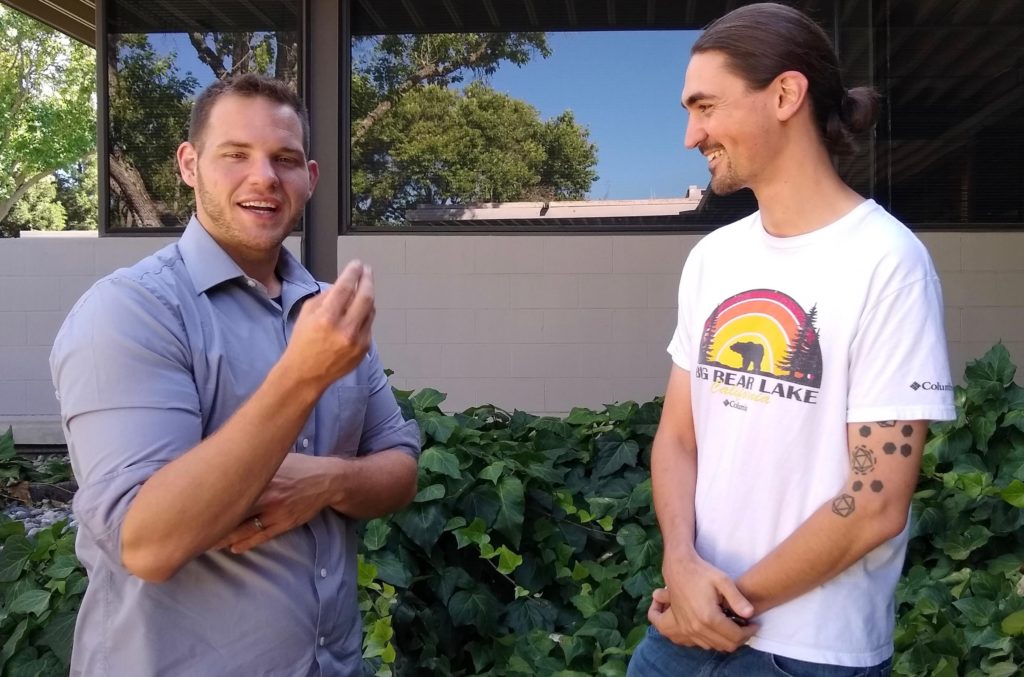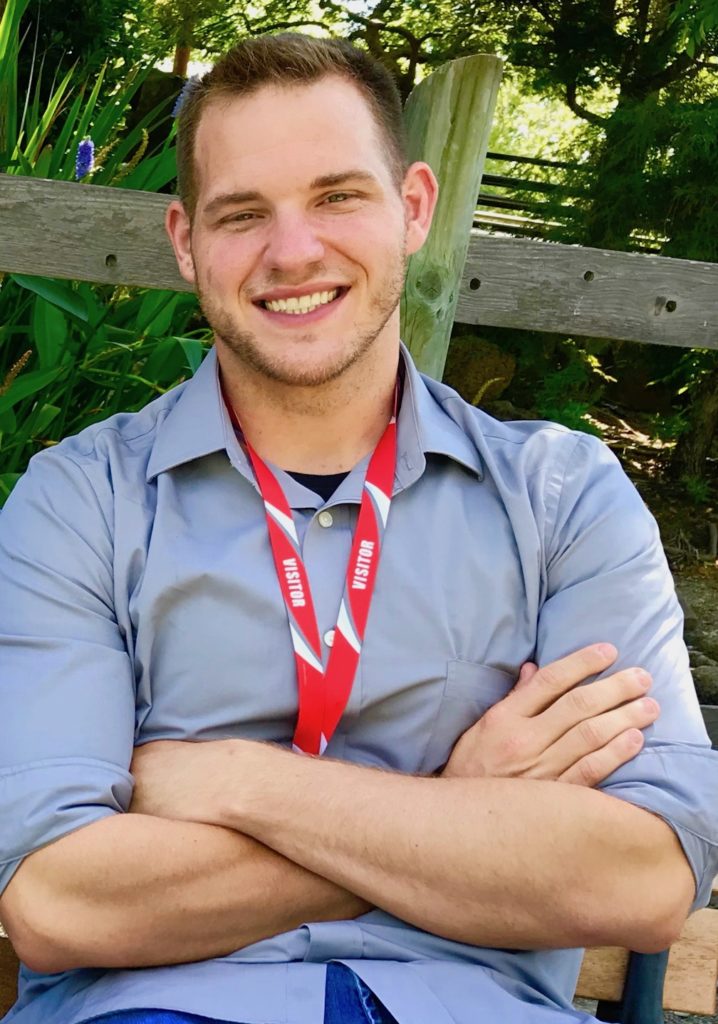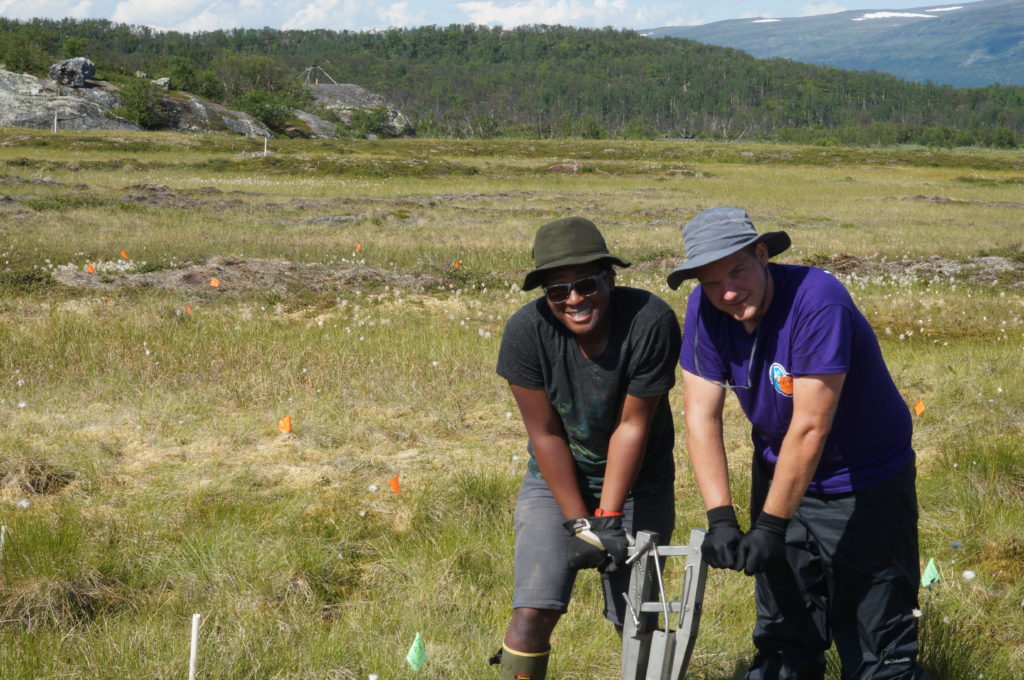Gary Trubl, a virologist at Lawrence Livermore National Laboratory, wants to understand how viruses impact the release of greenhouse gases from Arctic permafrost. But to see what they’re doing, he first needs their DNA.
The Joint Genome Institute presents the Genome Insider podcast.
Transcript of the episode
ALISON: Hey! I’m Alison Takemura. Welcome to the podcast of the US Department of Energy Joint Genome Institute, or JGI. Now, you might be wondering: why are we doing a podcast? Well, we realized that there’s nothing out there that’s entertaining, fresh, and funny that specializes in environmental genomic science. I know, right. Missed opportunity… So, we wanted to bring you that show. Imagine it’s like visiting a scientific colleague and they’re showing you their samples, their field site, walking around and waving their arms, telling you about what makes them so excited about their work.
We’ll be bringing you those kinds of stories from JGI’s scientific collaborators. They hail from all over the world, and study a dizzying array of organisms: from viruses to bacteria to fungi to corals and magnolia trees. I can’t wait to bring you their stories.
Today’s story starts in a substance we see all the time, but often don’t notice. It’s varied and mysterious — and marvelous. We start in soil.
GARY: Soil is just this complex matrix. You have so many things, I mean, if you just look at a small.. patch of soil, you’ll have all your larger organisms, you’ll have beetles, you’ll have nematodes, you have your worms, you can go smaller, you have your amoebas, different protists, you go down, then you have your bacteria, you go down even more and you have your viruses.
ALISON: That’s Gary Trubl, postdoc at Lawrence Livermore National Lab. He studies viruses that infect bacteria — and the big question on his mind is what are these viruses doing in soils in the Arctic.
He samples from a field site in northern Sweden.
And I want you to think about soil there as a layer cake: closer to the surface, the ground can get warm from the sun and air — so it can thaw. But deeper down, the layers remain frozen the whole year. And that’s permafrost. Plants can grow above the permafrost, but it’s so wet and cold and inhospitable there, that when they die, they don’t break down. And this..this is called peatland.
GARY: Right now, these peatlands, of where the permafrost is.. This is.. to give you an example, when I say peatland, this is soil that there’s so much vegetation material, so much plant biomass, that there’s actually a little bit of soil in that, and it’s mainly, it seems like plant material. And it has a different texture—until you really experience it, it’s hard to describe; I mean, the best way I guess would be the Tempur Pedic Swedish massage bed when you step on it how it’s (bop, bop, bop), it’s bouncy, kind of, when you walk along it? Walking along a peatland is like that. It’s kind of– it’s not hard soil, it’s kind of this bouncy material, where you’ve had this accumulation of plant material, because it hasn’t been degraded.
ALISON: These peatlands are currently a carbon sink, storing 30 to 50 percent of the world’s soil carbon. But the climate is warming. Peatlands are thawing more than they used to, so more of that spongy, dead plant material is all of a sudden available to microorganisms. They’re becoming more active.. So now, scientists are wondering if peatlands could become a carbon source, with microbes liberating carbon that’s been trapped underground for hundreds or even thousands of years.
But it’s not just microbes in the soil. There are viruses, too.
GARY: So I wanted to understand, what are the viruses doing? Now, when I was looking at the viruses in soil, I searched the literature, it’s the first thing we do to see what is known out there. Where do we start? How can we build these hypotheses. And there was not much.. if anything, and a lot of it was, ‘we counted some viruses in soils,’ or ‘we’ve done some minor lab experiments,’ but nothing really big. And I thought, well, why is this, this is crazy, there’s.. a wealth of knowledge in the marine world, we know that they’re important, and we care about them. And then when you look at soils, viruses may be there. And if you talk to a soil biologist, or someone that studies soil ecosystems, they will just disregard the viruses.
ALISON: But viruses could be really important. Say you have a big bacterial population munching on the dead plants, OK? Those bacteria are releasing carbon dioxide, or if the environment’s anoxic, then maybe they’re belching out methane, which is an even more potent greenhouse gas. If a virus comes along, infects and kills those bacteria, it could interrupt them from producing those greenhouse gases.
GARY: Now, that’s one way to look at it. The other way is, when they lyse these cells, they kill these hosts; they release these juicy nutrients. This is the microbial necromass, this is all the stuff that everything wants. So all the other microbes are like, hey, these are cheeseburgers, we’re going to eat these. Or a salad. And they’re super happy. And then.. it could help their metabolism. So they could be producing CO2.
ALISON: So viruses could be making more nutrients available, and that could make the bacteria metabolize even more than they might have without the viruses. Basically, the viruses could tip the scales either way. And for Gary, that’s intriguing.
GARY: ..one of the things that drove me to get a PhD is really understanding our Earth, our Gaia, our super, super organism, that all these interactions and really learning that microbes drive everything.
ALISON: How, exactly? Our understanding isn’t great.
GARY: It’s, it’s been difficult.
What we’ve learned is that viruses are actually highly abundant in soils, there is a range of 10 million to a billion viruses per gram of soil. This, this is massive: so 10 million to a billion per gram of soil.
There are populations, the different types of viruses that are there, they will fluctuate, you’ll have a huge pocket over here, you’ll have nothing over there. And we’ve been trying to figure out how we can really assess all this and describe it. In terms of, that we can describe the ecology of what’s going on.
ALISON: These organisms are microscopic, though, so being able to identify them and study them requires sequencing their DNA.
GARY: Now the problem is we can extract DNA from soil and, and look for the virus DNA specifically and almost get nothing. So.. this, this gap of how we think we see so many, but then when we extract their DNA, and we’re not getting it, there’s, there’s something going on there.
ALISON: So… Wh-what’s going on?
GARY: So then, if you look into the literature for soils. Soils are complex, we have these plant materials, creating these polysaccharides, you have humics, you have all these different organics that are in the soil. And this can mess with our ability to process DNA and analyze our samples.
ALISON: I’m going to say here that I can totally relate to Gary’s struggle. A long time ago during my own graduate studies, I isolated DNA from bacteria and they were living in a funky environment, too, just like Gary’s viruses. In my case, my bacteria were living on seaweed. And when I’d do a DNA extraction, I’d get … goop. The stuff in seaweed would contaminate the bacterial DNA.
[Eww, isn’t DNA supposed to be in a solution with the consistency of water?]
Yeah, you can imagine, uh, gross times. Anyway, let’s go back to Gary’s predicament. At this moment in his project, soil is not being his friend. So he decides he’s going to try several different extraction methods for preparing metagenomic DNA. Basically, he’s going to try different recipes — and he’ll pit them head to head. See which one does best.
GARY: So not only did I have the goal of trying to resuspend viruses from soil, but at the same time, trying to remove all this other schumtz that’s in there, so I can actually see the viruses—
ALISON: But, to get data from that stubborn DNA, he’s first going to need … a little more help. Luckily, Gary has two PIs during his time in grad school at The Ohio State University: Virginia Rich and Matt Sullivan. And when his PI Matt Sullivan hears that Gary is having a tough time with the viruses, he sees an opportunity.
GARY: He has a great working relationship with JGI, which he established. And he was looking at my project, and I was at the point where I didn’t, I didn’t even think that they could help out or what they could do, right? And he said, Well, let’s talk with some people at JGI, and see where this, where this goes. And then that’s when he started talking with Emiley—
ALISON: Emiley as in Emiley Eloe (e-low)-Fadrosh (fey-drosh). She leads JGI’s Metagenome Program. You’ll get to meet her in a later episode. Like Gary, she wanted to analyze those soil viruses, too.
GARY: She was interested in sequencing stuff, and then it went from there. She was really helping; she’s like, you know, I see why this is missing, I see this needs to be done. So I’m going to work with you guys, that you.. keep trying to get viruses from the soil—specifically, just the viral fraction—and JGI’s going to help sequence this.
ALISON: Fast-forward a couple years, and Gary publishes a way to extract viral DNA — even tiny, picogram amounts of it — from peatland soils.
SIMON: What is very exciting about what Gary has done, is basically, it’s very challenging to work with viruses in soil…
ALISON: This is Simon Roux, a research scientist at the JGI. He wants to know what viruses are doing in microbial ecosystems, and he worked with Gary on the project. Gary and I stopped by to see him.

Trubl (left) and Simon Roux (right), research scientist at the JGI, collaborate to uncover viruses in soil. (Photo by Alison F. Takemura)
SIMON: Studying viruses is hard. Viruses are small. They tend to not look like anything we know, they tend to stick everywhere, … that’s more of the physical stuff where it’s hard to take them out and separate them from the rest. And so eventually,..
ALISON: Scientists had great advances in aquatic environments like sea water, but…
SIMON: Soil had been kind of a frontier for our work for, what, 20 years, 30 years? Something like that.
ALISON: And in the last 4-5 years, a small number of groups have really tried to adapt, and make them finally work in soil.
SIMON: And Gary’s one of these people who took on this challenge, and actually succeeded… in most parts. There are still a few things we have to figure out. But like, he has just, you know, made the field progress so much—
ALISON: You can’t see it, but Gary’s grinning.
SIMON: But of all this, it’s basically, we knew viruses were there, we knew they were probably important, and we feel like finally we’ll be able to kind of measure and assess this, in a rigorous way, in a robust way. Before, it was just like, well they’re probably here, they are probably useful in some ways, they’re probably doing something, we don’t know.
Like finally, we’ll be able to be like ‘yeah, so that’s what they do.’
ALISON: The paper detailing Gary’s methods for extracting viral DNA — from both double-stranded AND single-stranded viruses — came out in July 2019. Simon was a co-author. You can find the paper — gloriously open source — in the show notes. There’s also a protocol with step-by-step instructions.
But the story’s not over yet! Getting the DNA is just the beginning. Gary wants to find out what the viruses are doing in the soil after all. So — the story continues. Tune in next time!
ACKNOWLEDGEMENTS
ALISON: This episode was directed and produced by me, Alison Takemura, with editorial and technical assistance from Massie Ballon and David Gilbert. Genome Insider is a production of the Joint Genome Institute, a user facility of the US Department of Energy Office of Science at Lawrence Berkeley National Lab in Berkeley, California.
Thanks today to our guests Gary Trubl and Simon Roux for sharing their expertise.
And special thanks to Matt Dozier, who writes the DOE podcast Direct Current, and Jenny Woodberry and Megan McCorkle, who produce the podcast Sound of Sience at Oak Ridge National Lab. They all generously answered my many questions about podcasting.
If you enjoyed the podcast and want to help others find us, leave us a review on Apple Podcasts, Google Play, or wherever you get your podcasts.
If you have a question or want to give us feedback, Tweet us @JGI or record a voice memo and email us at jgi dash comms at L-B-L.gov. That’s jgi dash c-o-m-m-s at l-b-l dot g-o-v.
And because we’re a user facility, if you’re interested in partnering with us, we want to hear from you! We have projects in genome sequencing, synthesis, transcriptomics, metabolomics, and natural products in plants, fungi, (fun-gee? fun-jai? fun-joe?) algae, and microorganisms. If you want to collaborate, let us know!
Find out more at jgi.doe.gov slash user dash programs. Thanks! and see you next time!
Additional information related to the episode
- Gary Trubl and Simon Roux’s PeerJ paper on viral DNA extraction: Towards optimized viral metagenomes for double-stranded and single-stranded DNA viruses from challenging soils
- Gary acknowledges his funding sources: “This IsoGenie work was funded by the Genomic Science Program of the United States Department of Energy Office of Biological and Environmental Research (grants DE-SC0010580 and DE-SC0016440), The Office of Science, Office of Workforce Development for Teachers and Scientists, Office of Science Graduate Student Research (SCGSR) program. The SCGSR program is administered by the Oak Ridge Institute for Science and Education (ORISE) for the DOE. ORISE is managed by ORAU under contract number DE-SC0014664. Work was performed under the auspices of the U.S. Department of Energy by Lawrence Livermore National Laboratory under contract no. DE-AC52-07NA27344.”
- A talk by microbial ecologist Virginia Rich at the Ohio State University on microbial metabolism in thawing permafrost at the JGI Annual Meeting in 2019
- Emiley Eloe-Fadrosh’s Environmental Genomics Group
- The JGI Metagenome Program
- Our contact info:
- Twitter: @JGI
- Email: jgi-comms at lbl dot gov

